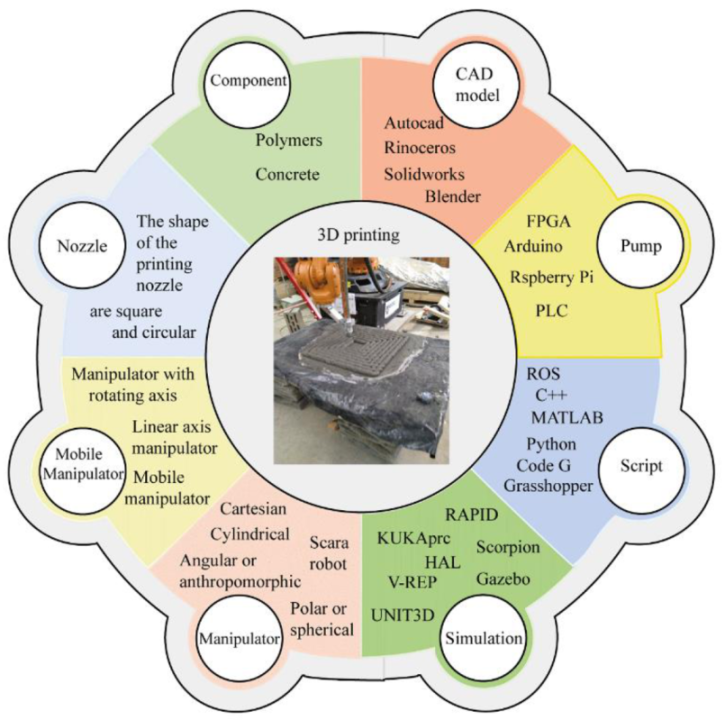
26
Feb
Research Report: Sustainable Design and Construction with 3D Printing Introduction
Research Report: Sustainable Design and Construction with 3D Printing
Introduction
Additive manufacturing, particularly 3D printing, is increasingly viewed as a potential solution for promoting sustainability in the construction industry. This technology allows for the creation of a whole house from a digital design, reducing both power and material consumption, and waste. This paper reviews the elements, merits, and demerits of employing 3D printing in construction and evaluates it as a promising technique for sustainable development.
Open Source 3-D Printers and OSATs
Open source 3-D printers can expedite self-directed sustainable development by facilitating the fabrication of open source appropriate technology (OSAT) using designs in the public domain. The RepRap and Fab@home exemplify open source 3-D printers that can produce OSATs from readily available resources. A new classification scheme for technically feasible and economically viable OSATs has been proposed. This includes a methodology for quantifying the properties of printed parts and outlines a research trajectory to enable complete village-level fabrication of OSATs.
Advantages and Limitations of 3D Printing Buildings
The new technology of 3D printing buildings offers many advantages, such as cost and time reduction, minimization of pollution, and decreased injuries on construction sites. Notable examples include Stupino town in Moscow, Russia, and Apis Cor, the first company to develop a mobile construction 3D printer. Despite these benefits, concerns and limitations exist. Building Information Modeling (BIM) integration with 3D printing is compared with traditional construction techniques. BIM integration with 3D printing modeling could lead to energy efficiency, better design, cost reduction, and isolation of structure.
Ecological Research and Sustainability Aspects
The advent of 3D printing technology has introduced revolutionary methods for testing community ecology theory and visual signaling hypotheses. Environmental costs should be taken into account when employing this technology, with efforts directed towards reducing, reusing, and recycling materials to minimize negative impacts.
In conjunction with implementing Industry 4.0, further sustainability aspects are highlighted. Large-scale use of 3D printing can help industries execute Industry 4.0 more effectively. Benefits include weight savings, waste minimization, and energy savings.
Lunar Habitat Development
Potential applications have also been identified in lunar habitat development using high-performance printing concrete specifically developed for use in 3D printing construction.
Aerospace Applications
The adoption of 3D printing processes over traditional manufacturing methods is gaining popularity within the aerospace sector due to their significant benefits despite limitations concerning material type, quality, and quantity.
Sustainable Infrastructure
Aligned with the United Nations’ 2030 agenda on sustainable development goals (SDGs), there is an emphasized need for sustainable infrastructure within the construction industry. Three-dimensional printing (3DP) technology has been recognized as an efficient method within architecture, engineering, and construction (AEC) sectors. It offers benefits such as economic growth, environmental safety, time reduction, and complex design customization.
Conclusion
Given the critical role the construction industry plays in global GDP coupled with its significant environmental footprint, there is an urgent need to transition towards more sustainable practices. The integration of IoT, cloud manufacturing (CM), and 3DP can provide reliable features to users and support digitalization in construction. Key recommendations for future enhancements include automation with robotics, predictive analytics in 3DP eco-friendly 3DP practices, and leveraging advancements such as 5G technology-based IoT-based CM.
Let’s work together to make sure that everyone has access to the benefits of clean energy, regardless of their income level. Share this article, repost it on social media, and comment below. Subscribe to the Sustainable Investing Digest to stay up-to-date on the latest news and trends in sustainable investing. Subscribe Today: https://www.linkedin.com/build-relation/newsletter-follow?entityUrn=7053058780464345088. Together, we can build a more sustainable future for everyone.